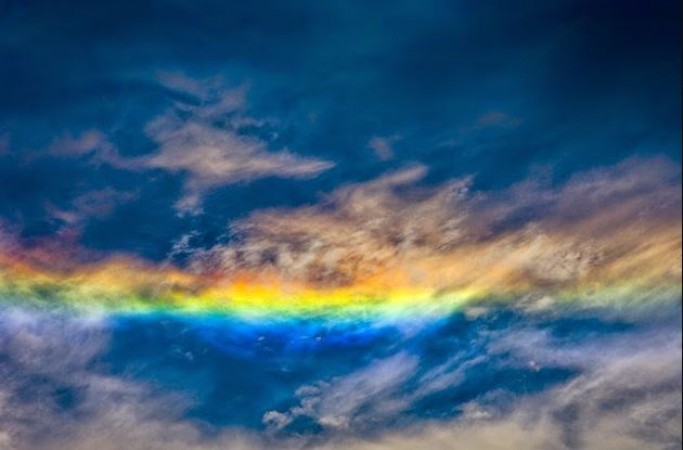
Have you ever looked up at the sky and witnessed a captivating display of colors resembling a rainbow, but it was parallel to the horizon instead of arcing across the sky? This stunning atmospheric phenomenon is known as a circumhorizontal arc, also commonly referred to as a fire rainbow. In this article, we will delve into the science behind these rare and breathtaking occurrences, exploring their formation, characteristics, and the factors that contribute to their appearance.
1. Introduction
Fire rainbows are a captivating optical phenomenon that can leave onlookers in awe of nature's wonders. These vibrant and striking displays of colors are not actually rainbows in the traditional sense but are caused by the refraction and dispersion of sunlight passing through ice crystals in high-altitude cirrus clouds. Let's delve deeper into the mechanics behind these mesmerizing spectacles.
2. What Are Circumhorizontal Arcs?
A circumhorizontal arc is an optical phenomenon that occurs when the Sun is high in the sky, typically during the summer months. It appears as a band of colors that stretches parallel to the horizon, reminiscent of a traditional rainbow. The term "fire rainbow" is derived from the intense and fiery hues often present in these arcs.
3. The Formation of Fire Rainbows
Fire rainbows form when sunlight enters ice crystals in cirrus clouds at a specific angle. The hexagonal shape of the ice crystals causes the light to refract, or bend, resulting in the separation of the different colors within the light spectrum. This dispersion of colors produces the brilliant display that characterizes circumhorizontal arcs.
4. Optimal Atmospheric Conditions
For a fire rainbow to occur, certain atmospheric conditions must align. First, cirrus clouds, which are thin and wispy, need to be present at high altitudes. These clouds are composed of ice crystals, which act as the prism for the sunlight. Second, the Sun needs to be high in the sky, typically above 58 degrees from the horizon, to create the necessary angle for the light to pass through the ice crystals and form the arc.
5. Angle of the Sun and Latitude
The angle of the Sun plays a crucial role in the visibility of circumhorizontal arcs. The higher the Sun is in the sky, the more likely it is to create the necessary angle for the sunlight to interact with the ice crystals. As a result, circumhorizontal arcs are more commonly observed in regions closer to the equator, where the Sun reaches greater heights during the day.
6. The Colors of Fire Rainbows
Fire rainbows are renowned for their vibrant and intense colors. These hues are a result of the dispersion of sunlight as it passes through the ice crystals in the cirrus clouds. The light separates into its constituent colors, similar to what occurs in a prism. The most common colors observed in a fire rainbow include red, orange, yellow, and green.
7. Differentiating Circumhorizontal Arcs from Other Phenomena
Circumhorizontal arcs are often mistaken for other atmospheric phenomena, such as sundogs or iridescent clouds. However, there are distinct differences that can help differentiate between them. Sundogs are bright spots on either side of the Sun, while iridescent clouds display a variety of colors spread across the sky. Fire rainbows, on the other hand, are large, parallel bands of colors that appear only when the Sun is at a specific angle.
8. Capturing the Beauty: Photography Tips
Photographing fire rainbows can be a challenging yet rewarding endeavor. To capture the vivid colors and intricate details, it is essential to use a polarizing filter and a wide-angle lens. Additionally, timing is crucial, as the arc is only visible for a short period when the Sun is at the correct angle. Patience and persistence are key when attempting to photograph this elusive phenomenon.
9. The Significance of Fire Rainbows
Beyond their breathtaking beauty, fire rainbows hold symbolic and cultural significance in various societies. They are often associated with good fortune, positive energy, and spiritual blessings. In some cultures, fire rainbows are considered rare and auspicious events, representing harmony, balance, and the bridging of heaven and earth.
10. Popular Misconceptions
Fire rainbows have fascinated people for centuries, leading to various misconceptions about their origins and meanings. One common misconception is that fire rainbows are caused by volcanic eruptions. However, these phenomena are unrelated to volcanic activity and solely result from the interaction of sunlight with ice crystals in cirrus clouds.
11. Fascinating Examples from Around the World
Fire rainbows have been witnessed in different parts of the world, leaving spectators in awe of their beauty. Notable occurrences have been recorded in the United States, Iceland, Australia, and several other countries. These natural wonders continue to captivate both scientists and enthusiasts alike, reminding us of the extraordinary and awe-inspiring elements of our planet.
12. Conclusion
Circumhorizontal arcs, commonly known as fire rainbows, are awe-inspiring atmospheric phenomena that showcase nature's remarkable beauty. These vivid bands of colors parallel to the horizon are the result of sunlight interacting with ice crystals in cirrus clouds. Understanding the science behind fire rainbows allows us to appreciate the intricate processes that occur in our atmosphere and serves as a reminder of the wonders that surround us.
Rupee Charges Ahead: Indian Currency Surges 6 Ps USDollar, Reflecting Investor Confidence
23 Airports Set for Major Upgrades to Boost Traffic and Elevate Travel Experience
Sensex and Nifty Soar to All-Time Highs, Fueling Investor Confidence in India's Economic Recovery